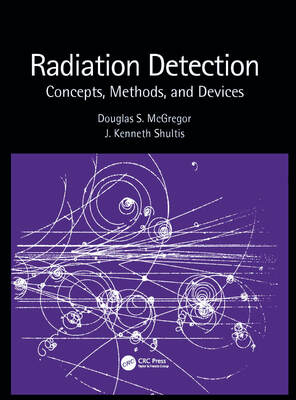
Radiation Detection: Concepts, Methods, and Devices
by Douglas S. McGregor and J. Kenneth Shultis
Radiation Detection: Concepts, Methods, and Devices provides a modern overview of radiation detection
devices and radiation measurement methods. The book topics have been selected on the basis of the authors’
many years of experience designing radiation detectors and teaching radiation detection and measurement in
classroom environment.
This book is designed to give the reader more than a glimpse at radiation detection devices and a few packaged
equations. Rather it seeks to provide an understanding that allows the reader to choose the appropriate detection
technology for a particular application, to design detectors, and to competently perform radiation measurements.
The authors describe assumptions used to derive frequently encountered equations used in radiation detection
and measurement, thereby providing insight when and when not to apply the many approaches used in different
aspects of radiation detection. Detailed in many of the chapters are specific aspects of radiation detectors,
including comprehensive reviews of the historical development and current state of each topic. Such a review
necessarily entails citations to many of the important discoveries, providing a resource to find quickly additional
and more detailed information.
This book generally has five main themes:
Topics covered include atomic and nuclear physics, radiation interactions, sources of radiation, and background radiation. Detector operation is addressed with chapters on radiation counting statistics, radiation source and detector effects, electrostatics for signal generation, solid-state and semiconductor physics, background radiations, and radiation counting and spectroscopy. Detectors for gamma-rays, charged-particles, and neutrons are detailed in chapters on gas-filled, scintillator, semiconductor, thermoluminescence and optically stimulated luminescence, photographic film, and a variety of other detection devices.
www.amazon.com/Radiation-Detection-Measurement-Concepts-Methods-dp-1439819394/dp/1439819394/ref=mt_other?_encoding=UTF8&me=&qid=1600356687
Also, from the publisher:
www.routledge.com/Radiation-Detection-Concepts-Methods-and-Devices/McGregor-Shultis/p/book/9781439819395
by Douglas S. McGregor and J. Kenneth Shultis
Radiation Detection: Concepts, Methods, and Devices provides a modern overview of radiation detection
devices and radiation measurement methods. The book topics have been selected on the basis of the authors’
many years of experience designing radiation detectors and teaching radiation detection and measurement in
classroom environment.
This book is designed to give the reader more than a glimpse at radiation detection devices and a few packaged
equations. Rather it seeks to provide an understanding that allows the reader to choose the appropriate detection
technology for a particular application, to design detectors, and to competently perform radiation measurements.
The authors describe assumptions used to derive frequently encountered equations used in radiation detection
and measurement, thereby providing insight when and when not to apply the many approaches used in different
aspects of radiation detection. Detailed in many of the chapters are specific aspects of radiation detectors,
including comprehensive reviews of the historical development and current state of each topic. Such a review
necessarily entails citations to many of the important discoveries, providing a resource to find quickly additional
and more detailed information.
This book generally has five main themes:
- Physics and Electrostatics needed to Design Radiation Detectors
- Properties and Design of Common Radiation Detectors
- Description and Modeling of the Different Types of Radiation Detectors
- Radiation Measurements and Subsequent Analysis
- Introductory Electronics Used for Radiation Detectors
Topics covered include atomic and nuclear physics, radiation interactions, sources of radiation, and background radiation. Detector operation is addressed with chapters on radiation counting statistics, radiation source and detector effects, electrostatics for signal generation, solid-state and semiconductor physics, background radiations, and radiation counting and spectroscopy. Detectors for gamma-rays, charged-particles, and neutrons are detailed in chapters on gas-filled, scintillator, semiconductor, thermoluminescence and optically stimulated luminescence, photographic film, and a variety of other detection devices.
www.amazon.com/Radiation-Detection-Measurement-Concepts-Methods-dp-1439819394/dp/1439819394/ref=mt_other?_encoding=UTF8&me=&qid=1600356687
Also, from the publisher:
www.routledge.com/Radiation-Detection-Concepts-Methods-and-Devices/McGregor-Shultis/p/book/9781439819395
Errata to Radiation Detection: Concepts, Methods, and Devices
Unfortunately, as with most large texts, we found several typographic errors. We managed to find numerous errors before the book went to press, but unfortunately, we did not find them all beforehand. We were warned by the publisher that we would probably find a lot of typographic errors and so on, but I thought "how bad can it be, I must have proofread the book 20 times?" Well, after the book was reformatted to reduce about 300 pages (from 1600 down to 1300), and probably fatigue from proofreading numerous times, here we are. I was wrong, the publisher was correct. So we found a lot of mistakes in the first printing, and maybe you can help us find others before the second printing. Please find attached an errata to the text. Also, should you find one not listed, please inform me of it through the contact location on this web site. Ken and I will gladly credit you with the find.
Unfortunately, as with most large texts, we found several typographic errors. We managed to find numerous errors before the book went to press, but unfortunately, we did not find them all beforehand. We were warned by the publisher that we would probably find a lot of typographic errors and so on, but I thought "how bad can it be, I must have proofread the book 20 times?" Well, after the book was reformatted to reduce about 300 pages (from 1600 down to 1300), and probably fatigue from proofreading numerous times, here we are. I was wrong, the publisher was correct. So we found a lot of mistakes in the first printing, and maybe you can help us find others before the second printing. Please find attached an errata to the text. Also, should you find one not listed, please inform me of it through the contact location on this web site. Ken and I will gladly credit you with the find.
| rdbook-errata-06192024.pdf | |
| File Size: | 709 kb |
| File Type: | |